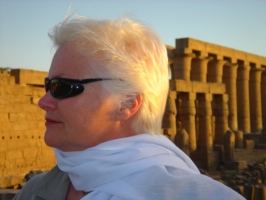My B&B didn’t have wi-fi, so I had to go to the Weymouth Library to use theirs. I realized that the two middle-aged women huddled across the table from me were working through a book together. One was apparently the tutor, the other was learning to read.
I take my literacy for granted, and on this trip I’ve indeed built my travels around books, authors, and literature. From Charles Dickens to Thomas Hardy to Jane Austen to William Shakespeare to Tracy Chevalier, I’ve visited many literary sites. I have benefited from my parents’ DNA, my grandparents’ Dutch and German cultures valuing education, my mother reading aloud to us, a literary home environment, my good eyesight, normal learning abilities, and good schools and teachers. And here, at the Weymouth Library, was an adult woman who was just getting started on her journey to literacy.
I listened as the tutor was very patient with her student as they went through a couple of different books. One book seemed to be a romance novel, judging from their quiet discussion of a woman having an affair with a married man. Could it have been a Mills & Boon romance they were reading? The M&B publisher is criticized for its low-brow and formulaic books, but the books are in a form and at a price within reach of a wide readership.
Feminists say these novels are mostly rape fantasies, full of misogyny and hate speech, promoting a disregard for sexual health. With their predictable, happy endings, M&B novels could be at least partly responsible for many readers’ broken relationships. Or perhaps readers’ relationships already broken drive their appeal. And why are the heroes so often powerful billionaires, princes, and tycoons? And usually Greek or Arab? Should these books be kept away from beginning adult readers, or do they somehow reflect the needs and worries of semi-literate and illiterate women who are hoping for perfection, idealism, and escape? The men characters are often masterful and stern, both frightening and fascinating. The women characters often yearn for salvation, both financial and romantic.
The publishing house founded in 1908 by Gerald Mills and Charles Boon moved towards escapist fiction in the 1930s. Almost 100 new Mills & Boon romance novels in their 20 imprints* are released every month. (That was in2014; releases as of 2022 now number 100 every month.) The publishers seem to definitely have their fingers on a female literary pulse.
And might that have been me in different circumstances, sitting with a tutor in a seaside library? Had
I lived in a different part of the world with different parents–in a different school system and living a different life altogether–might that have been me struggling through a Mills & Boon with a tutor? And how different was it that a teenaged me was captivated by the longings and drama of Wuthering Heights, a book many found shocking and immoral when it was first published?
* Imprints include Sensual Romance, Black Lace, Heroes, Silhouette, Desire, Desire, Intrigue, Medical, Cherish, By Request, Historical, and simply Romance. M&B stories now range from traditional romance to sexually explicit. In 1971, Mills & Boon became an imprint itself of Harlequin Enterprises.

Post a Comment